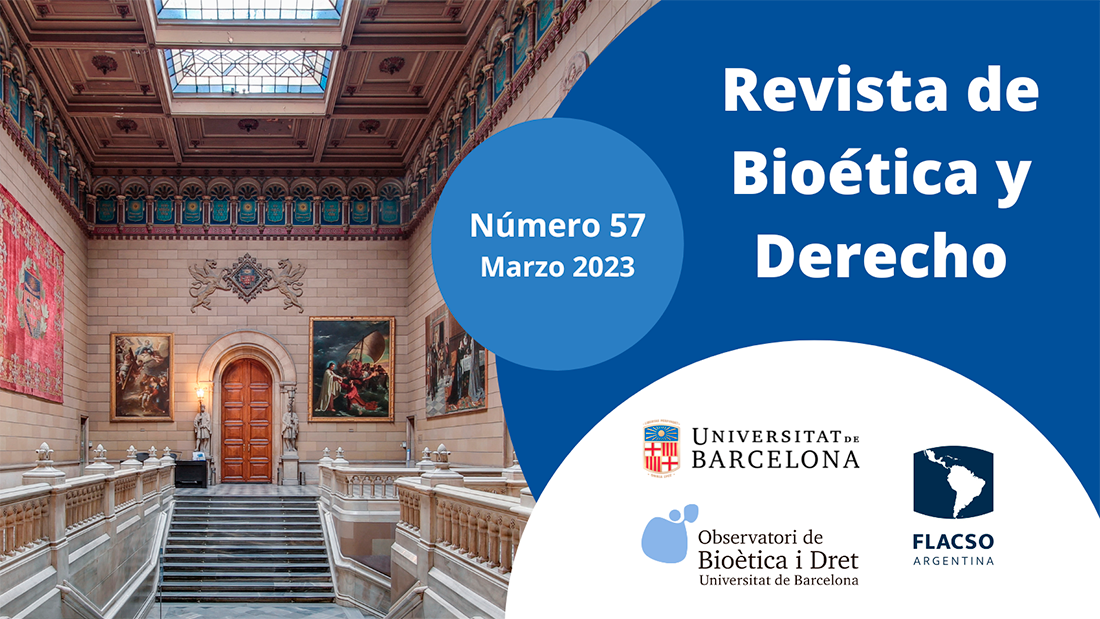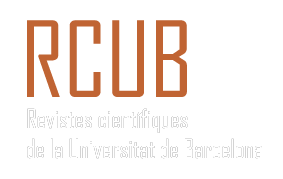Bioethics issues related to Artificial Intelligence in Health: an exploratory study
DOI:
https://doi.org/10.1344/rbd2023.57.35146Keywords:
bioética, inteligência artificial, cuidado em saúdeAbstract
Objective: to analyze the perception of users of social networks regarding the use of AI systems in the field of health and the bioethical aspects associated with this use. Method: Mixed method study, of the descriptive-exploratory type. The methodological path was divided into two stages: (1) gathering information about the main bioethical aspects involved in the use of AI and (2) elaboration of decision-making scenarios. Quantitative data were analyzed using descriptive statistics in order to characterize the sample from a sociodemographic point of view, as well as to characterize the sample's decision-making profile regarding bioethical issues associated with the use of AI systems. Qualitative data analysis was performed using Bardin's content analysis. Results: with regard to the sociodemographic profile, a sample of female adults with a university degree can be observed. With regard to the ethical concerns associated with the applied scenarios, the main concerns were in the first place the privacy and confidentiality of the data, followed by concerns related to the responsibility associated with the use of these technologies, as well as informed consent. Conclusion: In this way, the importance of new exploratory empirical studies like this one is highlighted, evaluating the perception, attitudes and opinions of specialized audiences, such as professionals in the health, law, humanities, in order to obtain concrete evidence to the development of management and governance programs for AI systems, especially in the Brazilian scenario, where resources are scarce.
References
Astromskė, K., Peičius, E., & Astromskis, P. (2020). Ethical and legal challenges of informed consent applying artificial intelligence in medical diagnostic consultations. AI & SOCIETY. https://doi.org/10.1007/s00146-020-01008-9
Ayoub, A., & Pulijala, Y. (2019). The application of virtual reality and augmented reality in Oral & Maxillofacial Surgery. BMC Oral Health, 19, 1–8. https://doi.org/10.1186/s12903-019-0937-8
Baig, M. A., Almuhaizea, M. A., Alshehri, J., Bazarbashi, M. S., & Al-Shagathrh, F. (2020). Urgent Need for Developing a Framework for the Governance of AI in Healthcare. Studies in Health Technology and Informatics, 272, 253–256. https://doi.org/10.3233/SHTI200542
Bandman, E. L., & Bandman, B. (1984). Bioethics and Human Rights: A Reader for Health Professionals. Univ Pr of Amer.
Bardin, L. (2011). Análise de Conteúdo (2nd ed.). Edições 70. https://books.google.com.br/books?id=AFpxPgAACAAJ
Bazeley, P. (2013). QUALITATIVE DATA ANALYSIS: PRACTICAL STRATEGIES. SAGE Publications, Inc.
Bazeley, P., & Jackson, K. (2013). Qualitative Data Analysis with Nvivo. SAGE Publications, Inc.
Beauchamp, T. (2010). Standing on principles. Oxford University Press.
Beauchamp, T. L., & Childress, J. F. (2013). Principles of Biomedical Ethics (7th ed.). Oxford University Press.
Blease, C., Kaptchuk, T. J., Bernstein, M. H., Mandl, K. D., Halamka, J. D., & Desroches, C. M. (2019). Artificial intelligence and the future of primary care: exploratory qualitative study of UK general practitioners’ views. Journal of Medical Internet Research, 21(3). https://doi.org/10.2196/12802
Brasil. (2018). Lei Geral de Proteção de Dados Pessoais (LGPD). DOU, 14 de Agosto de 2018. http://www.planalto.gov.br/ccivil_03/_ato2015-2018/2018/lei/l13709.htm
Cath, C., Wachter, S., Mittelstadt, B., Taddeo, M., & Floridi, L. (2018). Artificial Intelligence and the ‘Good Society’: the US, EU, and UK approach. Science and Engineering Ethics, 24(2), 505–528. https://doi.org/10.1007/s11948-017-9901-7
Chianca, V., Cuocolo, R., Gitto, S., Albano, D., Merli, I., Badalyan, J., Cortese, M. C., Messina, C., Luzzati, A., Parafioriti, A., Galbusera, F., Brunetti, A., & Sconfienza, L. M. (2021). Radiomic Machine Learning Classifiers in Spine Bone Tumors: A Multi-Software, Multi-Scanner Study. European Journal of Radiology, 137, 109586. https://doi.org/10.1016/j.ejrad.2021.109586
Coeckelbergh, M. (2020). Artificial Intelligence, Responsibility Attribution, and a Relational Justification of Explainability. Science and Engineering Ethics, 26(4), 2051–2068. https://doi.org/10.1007/s11948-019-00146-8
Creswell, J. ., & Clark, V. L. P. (2015). Pesquisa de Métodos Mistos (2a). Penso Editora.
Cui, M., & Zhang, D. Y. (2021). Artificial intelligence and computational pathology. Laboratory Investigation, 101(4), 412–422. https://doi.org/10.1038/s41374-020-00514-0
Do, H. M., Spear, L. G., Nikpanah, M., Mirmomen, S. M., Machado, L. B., Toscano, A. P., Turkbey, B., Bagheri, M. H., Gulley, J. L., & Folio, L. R. (2020). Augmented Radiologist Workflow Improves Report Value and Saves Time: A Potential Model for Implementation of Artificial Intelligence. Academic Radiology, 27(1), 96–105. https://doi.org/10.1016/j.acra.2019.09.014
Ekmekci, P. E., & Arda, B. (2020). History of Artificial Intelligence (pp. 1–15). https://doi.org/10.1007/978-3-030-52448-7_1
Emanuel, E. J., & Wachter, R. M. (2019). Artificial Intelligence in Health Care. JAMA, 321(23), 2281. https://doi.org/10.1001/jama.2019.4914
Faleiros, M. C., Nogueira-Barbosa, M. H., Dalto, V. F., Júnior, J. R. F., Tenório, A. P. M., Luppino-Assad, R., Louzada-Junior, P., Rangayyan, R. M., & de Azevedo-Marques, P. M. (2020). Machine learning techniques for computer-aided classification of active inflammatory sacroiliitis in magnetic resonance imaging. Advances in Rheumatology, 60(1), 25. https://doi.org/10.1186/s42358-020-00126-8
Floridi, L., Cowls, J., Beltrametti, M., Chatila, R., Chazerand, P., Dignum, V., Luetge, C., Madelin, R., Pagallo, U., Rossi, F., Schafer, B., Valcke, P., & Vayena, E. (2018). AI4People—An Ethical Framework for a Good AI Society: Opportunities, Risks, Principles, and Recommendations. Minds and Machines, 28(4), 689–707. https://doi.org/10.1007/s11023-018-9482-5
Goldim, J. R. (2006). Bioética: Origens e complexidade. Rev HCPA, 26(2).
Goldim, J. R. (2009). [Complex bioethics: a comprehensive approach to decision making process]. Revista AMRIGS, 53(1), 58–63.
Goldim, J. R. (2016). Bioethics after Levinas. In eLS (pp. 1–4). John Wiley & Sons, Ltd. https://doi.org/10.1002/9780470015902.a0026694
Haenlein, M., & Kaplan, A. (2019). A Brief History of Artificial Intelligence: On the Past, Present, and Future of Artificial Intelligence. California Management Review, 61(4), 5–14. https://doi.org/10.1177/0008125619864925
Husnayain, A., Shim, E., Fuad, A., & Su, E. C.-Y. (2020). Understanding the Community Risk Perceptions of the COVID-19 Outbreak in South Korea: Infodemiology Study. Journal of Medical Internet Research, 22(9), e19788. https://doi.org/10.2196/19788
Johnson, S. L. J. (2019). AI, Machine Learning, and Ethics in Health Care. The Journal of Legal Medicine, 39(4), 427–441. https://doi.org/10.1080/01947648.2019.1690604
Jonas, H. (2006). O principio responsabilidade: ensaio de uma etica para a civilização tecnologica. Contraponto.
Kaul, V., Enslin, S., & Gross, S. A. (2020). History of artificial intelligence in medicine. Gastrointestinal Endoscopy, 92(4), 807–812. https://doi.org/10.1016/j.gie.2020.06.040
Larson, D. B., Magnus, D. C., Lungren, M. P., Shah, N. H., & Langlotz, C. P. (2020). Ethics of Using and Sharing Clinical Imaging Data for Artificial Intelligence: A Proposed Framework. Radiology, 192536. https://doi.org/10.1148/radiol.2020192536
Lin, S. Y., Mahoney, M. R., & Sinsky, C. A. (2019). Ten Ways Artificial Intelligence Will Transform Primary Care. Journal of General Internal Medicine. https://doi.org/10.1007/s11606-019-05035-1
Liyanage, H., Liaw, S.-T., Jonnagaddala, J., Schreiber, R., Kuziemsky, C., Terry, A., & de Lusignan, S. (2019a). Artificial Intelligence in Primary Health Care: Perceptions, Issues, and Challenges. Yearbook of Medical Informatics. https://doi.org/10.1055/s-0039-1677901
Liyanage, H., Liaw, S.-T., Jonnagaddala, J., Schreiber, R., Kuziemsky, C., Terry, A. L., & de Lusignan, S. (2019b). Artificial Intelligence in Primary Health Care: Perceptions, Issues, and Challenges. Yearbook of Medical Informatics, 28(01), 041–046. https://doi.org/10.1055/s-0039-1677901
Lopez-Jimenez, F., Attia, Z., Arruda-Olson, A. M., Carter, R., Chareonthaitawee, P., Jouni, H., Kapa, S., Lerman, A., Luong, C., Medina-Inojosa, J. R., Noseworthy, P. A., Pellikka, P. A., Redfield, M. M., Roger, V. L., Sandhu, G. S., Senecal, C., & Friedman, P. A. (2020). Artificial Intelligence in Cardiology: Present and Future. Mayo Clinic Proceedings, 95(5), 1015–1039. https://doi.org/10.1016/j.mayocp.2020.01.038
Marquis, P., Papini, O., & Prade, H. (2020). Elements for a History of Artificial Intelligence. In A Guided Tour of Artificial Intelligence Research (pp. 1–43). Springer International Publishing. https://doi.org/10.1007/978-3-030-06164-7_1
Martin, A., Nateqi, J., Gruarin, S., Munsch, N., Abdarahmane, I., Zobel, M., & Knapp, B. (2020). An artificial intelligence-based first-line defence against COVID-19: digitally screening citizens for risks via a chatbot. Scientific Reports, 10(1), 19012. https://doi.org/10.1038/s41598-020-75912-x
Morley, J., Machado V, C. C., Burr, C., Cowls, J., Joshi, I., Taddeo, M., & Floridi, L. (2020). The ethics of AI in health care: A mapping review. SOCIAL SCIENCE & MEDICINE, 260. https://doi.org/10.1016/j.socscimed.2020.113172
Oren, O., Gersh, B. J., & Bhatt, D. L. (2020). Artificial intelligence in medical imaging: switching from radiographic pathological data to clinically meaningful endpoints. The Lancet Digital Health, 2(9), e486–e488. https://doi.org/10.1016/S2589-7500(20)30160-6
Price, W. N. 2nd, & Cohen, I. G. (2019). Privacy in the age of medical big data. Nature Medicine, 25(1), 37–43. https://doi.org/10.1038/s41591-018-0272-7
Racine, E., Boehlen, W., & Sample, M. (2019). Healthcare uses of artificial intelligence: Challenges and opportunities for growth. Healthcare Management Forum, 32(5), 272–275. https://doi.org/10.1177/0840470419843831
Reddy, S., Allan, S., Coghlan, S., & Cooper, P. (2020). A governance model for the application of AI in health care. Journal of the American Medical Informatics Association, 27(3), 491–497. https://doi.org/10.1093/jamia/ocz192
Risling, T. L., & Low, C. (2019). Advocating for Safe, Quality and Just Care: What Nursing Leaders Need to Know about Artificial Intelligence in Healthcare Delivery. Nursing Leadership (Toronto, Ont.), 32(2), 31–45. https://doi.org/10.12927/cjnl.2019.25963
Soltan, A. A. S., Kouchaki, S., Zhu, T., Kiyasseh, D., Taylor, T., Hussain, Z. B., Peto, T., Brent, A. J., Eyre, D. W., & Clifton, D. A. (2021). Rapid triage for COVID-19 using routine clinical data for patients attending hospital: development and prospective validation of an artificial intelligence screening test. The Lancet Digital Health, 3(2), e78–e87. https://doi.org/10.1016/S2589-7500(20)30274-0
Tang, X. (2020). The role of artificial intelligence in medical imaging research. BJR|Open, 2(1), 20190031. https://doi.org/10.1259/bjro.20190031
Tsiknakis, N., Trivizakis, E., Vassalou, E., Papadakis, G., Spandidos, D., Tsatsakis, A., Sánchez‑García, J., López‑González, R., Papanikolaou, N., Karantanas, A., & Marias, K. (2020). Interpretable artificial intelligence framework for COVID‑19 screening on chest X‑rays. Experimental and Therapeutic Medicine, 20(2), 727–735. https://doi.org/10.3892/etm.2020.8797
UNESCO. (2009). The UNESCO Universal Declaration on Bioethics and Human Rights Background , principles and application (H. A. M. J. ten Have & M. S. Jean (eds.)). United Nations Educational. http://www.unesco-chair-bioethics.org/wp-content/uploads/2015/08/The-UNESCO-Universal-Declaration-on-Bioethics-and-Human-Rights-Background-Principles-and-Application.pdf
Uusitalo, S., Tuominen, J., & Arstila, V. (2020). Mapping out the philosophical questions of AI and clinical practice in diagnosing and treating mental disorders. Journal of Evaluation in Clinical Practice, jep.13485. https://doi.org/10.1111/jep.13485
Visweswaran, S., Colditz, J. B., O’Halloran, P., Han, N.-R., Taneja, S. B., Welling, J., Chu, K.-H., Sidani, J. E., & Primack, B. A. (2020). Machine Learning Classifiers for Twitter Surveillance of Vaping: Comparative Machine Learning Study. Journal of Medical Internet Research, 22(8), e17478. https://doi.org/10.2196/17478
Weikert, T., Winkel, D. J., Bremerich, J., Stieltjes, B., Parmar, V., Sauter, A. W., & Sommer, G. (2020). Automated detection of pulmonary embolism in CT pulmonary angiograms using an AI-powered algorithm. European Radiology, 30(12), 6545–6553. https://doi.org/10.1007/s00330-020-06998-0
Woo, H., Cho, Y., Shim, E., Lee, J.-K., Lee, C.-G., & Kim, S. H. (2016). Estimating Influenza Outbreaks Using Both Search Engine Query Data and Social Media Data in South Korea. Journal of Medical Internet Research, 18(7), e177. https://doi.org/10.2196/jmir.4955
Yetisen, A. K., Martinez-Hurtado, J. L., Ünal, B., Khademhosseini, A., & Butt, H. (2018). Wearables in Medicine. Advanced Materials, 30(33), 1706910. https://doi.org/10.1002/adma.201706910
Zhang, J., Oh, Y. J., Lange, P., Yu, Z., & Fukuoka, Y. (2020). Artificial Intelligence Chatbot Behavior Change Model for Designing Artificial Intelligence Chatbots to Promote Physical Activity and a Healthy Diet: Viewpoint. Journal of Medical Internet Research, 22(9), e22845. https://doi.org/10.2196/22845
Downloads
Published
How to Cite
Issue
Section
License
Copyright (c) 2023 Leonardo de Oliveira, Lucas Garcia, Evelise Duarte, Fagner de Moura

This work is licensed under a Creative Commons Attribution-NonCommercial-NoDerivatives 4.0 International License.
 The author retains the copyright and grants Revista de Bioética y Derecho the right of first publication of the article. All articles published in Revista de Bioética y Derecho are under Creative Commons licensing Recognition – Non Commercial – NoDerivedArtwork (by-nc-nd 4.0), which allows sharing the content with third parties, provided that they acknowledge its authorship, initial publication in this journal and the terms of the license. No commercial use of the original work or generation of derivative works is permitted.
The author retains the copyright and grants Revista de Bioética y Derecho the right of first publication of the article. All articles published in Revista de Bioética y Derecho are under Creative Commons licensing Recognition – Non Commercial – NoDerivedArtwork (by-nc-nd 4.0), which allows sharing the content with third parties, provided that they acknowledge its authorship, initial publication in this journal and the terms of the license. No commercial use of the original work or generation of derivative works is permitted.







